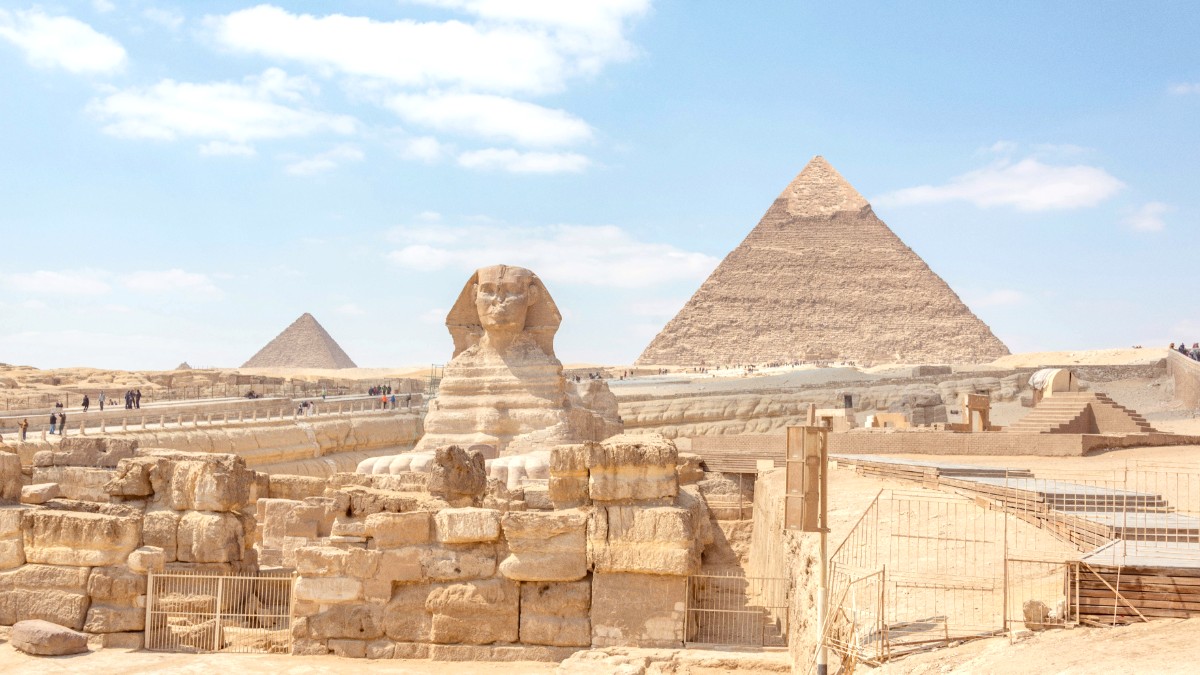
Cairo, Egypt
Egyptian food uses fresh, local ingredients, notably vegetables, legumes, and spices. It is known for hearty, comforting, often vegetarian-friendly dishes. The Nile Valley's fertility offers abundant produce, forming the basis of many meals.
Regional variations within Egypt exist. Cairo offers a diverse range, while specific dishes might be more prominent elsewhere. For example, Upper Egypt may present more pigeon dishes, and coastal areas highlight seafood.
Rice is a staple, often with main dishes. Bread, especially Aish Baladi (local flatbread), accompanies almost every meal. Fava beans (ful medames), lentils, and chickpeas are fundamental, forming the base of many nutritious dishes.
Onions, garlic, tomatoes, potatoes, aubergines, okra, and molokhia (jute mallow) are widely used. Chicken and beef are common. Pigeon is a local delicacy. Pork is generally not consumed due to Islamic dietary laws.
Cumin, coriander, chili, mint, parsley, and dill are frequently used. Egyptian cuisine generally has savory, rich, and earthy flavors, less spicy than some other Middle Eastern cuisines, focusing more on aromatic spices and fresh herbs.
Egypt's national dish. This hearty, vegetarian meal combines rice, macaroni, lentils, and chickpeas. It comes topped with a spicy tomato sauce, garlic vinegar, and crispy fried onions. Find it widely at specialized Koshary restaurants and from street food stalls.
A uniquely Egyptian comfort food.
Stewed fava beans. This breakfast staple comes served with olive oil, cumin, and often lemon juice. Find it from street carts to restaurants, often as a main dish or in sandwiches.
A foundational Egyptian breakfast.
An Egyptian meat pie. Spiced minced meat bakes inside aish baladi (local flatbread). It is a savory, filling dish, found in local bakeries or specialized eateries.
A flavorful savory pastry.
A traditional Egyptian bread pudding with milk, nuts, coconut, and raisins, baked until golden.
Basbousa: a sweet semolina cake soaked in sugar syrup. Konafa: shredded phyllo dough pastry with creamy cheese or nuts inside, soaked in syrup.
Many luxury hotels in Cairo, like the Four Seasons, Nile Ritz-Carlton, and Marriott Mena House, present international and upscale Egyptian cuisine restaurants. These locations offer high-quality dining settings with sophisticated menus and ambiance.
Numerous independent restaurants present a mix of local and international fare. You will find these in areas like Zamalek, Maadi, and some parts of Giza. They offer comfortable settings and good food at reasonable prices.
Street food is abundant throughout Cairo, especially in Downtown and near markets like Khan el-Khalili. Look for popular stalls with high customer turnover. Local cafeterias offer traditional Egyptian dishes at very affordable prices. These are simple but provide authentic flavors.
Cairo presents a wide array of international restaurants, including Italian, Chinese, Indian, and American fast food choices.
Common in upscale neighborhoods and modern shopping malls across the city.
Khan el-Khalili Bazaar has several traditional cafes like El Fishawy Cafe.
Local fresh produce markets are for purchasing ingredients, not prepared food.
Several hotels/restaurants near Giza offer meals with direct Pyramids views, notably memorable at sunset or during the Sound and Light Show.
These cruises present a buffet meal and entertainment (belly dancing, Tanoura shows) while sailing along the Nile River, a distinct perspective of Cairo by night.
Beyond Koshary and Ta'ameya sandwiches, find fresh sugar cane juice, grilled corn, and roasted sweet potatoes. Aish baladi itself is a street food occasion.
A historic cafe in Khan el-Khalili, popular for tea, coffee, and shisha, offering an authentic atmosphere.
Dining with specific allergies can present a challenge. While rice is common, wheat is a staple (in bread, and in pasta used in koshary). The language barrier can make communicating specific allergies difficult.
A Translation card detailing your allergies in Arabic can be helpful.
Research restaurants online before your visit. Contact hotels in advance to discuss their ability to accommodate your needs. Utilize translation apps to communicate clearly with restaurant staff.
Focus on single-ingredient dishes like grilled meats or plain rice when uncertain.
For cooking classes and food tours, many local tour operators and online platforms (like GetYourGuide) present options. Book in advance, especially for popular experiences.
When trying street food, look for places with high customer turnover. This often indicates freshness and popularity.
Hands-on sessions to prepare traditional Egyptian dishes like koshary or molokhia. These classes often include a visit to a local market to purchase ingredients.
Guided walks through local markets and eateries. Discover hidden culinary gems and understand the food culture.
Less common in Giza or central Cairo. These are found more in rural areas, for insight into the source of Egypt's produce.
Ramadan: Islamic holy month of fasting and festive evening meals. Dates vary annually.
Eid al-Fitr & Eid al-Adha: Major Islamic holidays with celebrations. Some businesses may have altered hours.
This annual event takes place in November or December, drawing international and local filmmakers.
Check local listings for specific dates and venues.
More prevalent outside of Cairo in rural areas or oases. These initiatives focus on local crafts, traditional hospitality, and directly benefit local communities. Inquire with specialized tour operators.
Short Arabic language courses or introductory lessons are available in Cairo for those interested in learning basic phrases. Look for cultural centers or private tutors.
This twice-yearly festival (February and October) at the Abu Simbel temples near Aswan is a significant cultural event, requiring travel to Upper Egypt. It presents an unique astronomical alignment.
Tipping (Baksheesh) is customary in Egypt for good service in restaurants and for guides. A gratuity of 10-15% is common for sit-down meals.